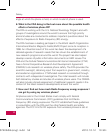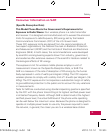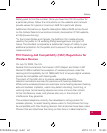
60
Safety
antenna, the lower the power output.
Before a phone model is available for sale to the public, it must be tested
and certified to the FCC that it does not exceed the limit established by
the governmentadopted requirement for safe exposure. The tests are
performed in positions and locations (e.g., at the ear and worn on the
body) as required by the FCC for each model.
This device was tested for typical body-worn operations with the back
of the phone kept 0.79 inches (2.0 cm) between the user’s body and the
back of the phone. To comply with FCC RF exposure requirements, a
minimum separation distance of 0.79 inches (2.0 cm) must be maintained
between the user s body and the back of the phone. Third-party belt-clips,
holsters, and similar accessories containing metallic components should
not be used. Body-worn accessories that cannot maintain 0.79 inches
(2.0 cm) separation distance between the user’s body and the back of the
phone, and have not been tested for typical body-worn operations may
not comply with FCC RF exposure limits and should be avoided.
The FCC has granted an Equipment Authorization for this model phone
with all reported SAR levels evaluated as in compliance with the FCC RF
emission guidelines.
The highest SAR value for this model phone when tested for use at the
ear is 1.36 W/kg and when worn on the body, is 0.74 W/kg. While there
may be differences between SAR levels of various phones and at various
positions, they all meet the government requirement for safe exposure.
SAR information on this model phone is on file with the FCC and can be
found under the Display Grant section of http://www.fcc.gov/oet/fccid
after searching on FCC ID BEJVS740.
To find information that pertains to a particular model phone, this site
uses the phone FCC ID number which is usually printed somewhere on
the case of the phone. Sometimes it may be necessary to remove the
US740GSG(eng).indd 60 2010.10.12 10:39:43 AM


















